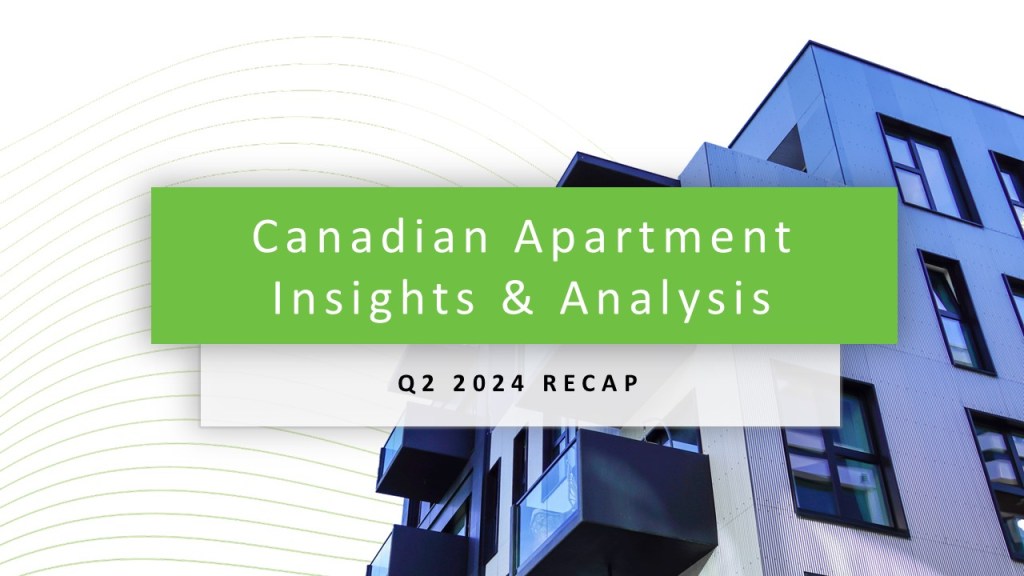
We’ve got some exciting updates from the latest Yardi Canadian National Multifamily Report for Q3 2024, recapping changes from April to June. This report, our first on the Breezeway, draws on data from Yardi’s extensive database, covering over 475,000 units and 5,400 properties nationwide. We’re sharing a sneak peek of the key insights, but you’ll definitely want to download the full report to dive deeper into the stats and trends!
The scoop on rent & vacancy rates
The Canadian apartment market is cooling slightly, but don’t grab your sweater just yet. Demand for housing is still high compared to supply. Rent growth and vacancy rates have decreased from their peak levels; however, they remain significantly higher compared to long-term trends.
Economic & employment updates
Canada’s economy is ticking along at a modest pace with a 1.7% GDP growth in the first quarter as per statistics Canada. Consumer spending, especially on services like rent and travel, is keeping the engine running. The national unemployment rate rose a bit, hitting 6.4% in June. However, it’s still below the long-term average. Interestingly, the 25-to-54-year-old group is doing well with a 5.4% unemployment rate, while younger Canadians face higher unemployment at 13.5%.
Interest rates & inflation
In July of 2024, the Bank of Canada took the lead over the U.S. Federal Reserve by cutting the policy rate to 4.75% in June. This move aims to stimulate the economy. Although inflation gave us a little scare by ticking up in May, it eased back down to a comfy 2.7% in June. Lower rates could mean more money in homeowners’ pockets, translating to higher economic growth.
Construction trends
Despite ongoing demand, apartment construction is struggling to keep up. In 2023, Canada delivered a multi-decade high of 112,819 apartments, contributing significantly to housing development. However, issues like financing, municipal approvals and worker shortages are slowing progress. So how has this impacted market performance?
Rent growth by the numbers
Nationally, the average rent increased by $18 in Q2 2024, hitting a record high of $1,521. This marks a 1.2% rise quarter-over-quarter and a 6.3% jump year-over-year. While rent growth is slowing, it’s still strong due to a robust demand driven by population growth.
Lease-over-lease rent growth
The growth rate in Canada for lease-over-lease rents, which reflects the increase in rent prices for new leases on units that have become vacant and are re-leased, moderated slightly to 10% in Q2 2024. Despite this decrease, it remains exceptionally high by historical standards. This growth is driven by strong demand and limited supply in Census Metropolitan Areas (CMAs) like Halifax, London and Kitchener-Cambridge-Waterloo, where rental markets are particularly tight.
Mixed bag of vacancy rates
At a 3% national vacancy rate, turnover represents roughly 11 days, which is considered tight for the industry. This tightness means that property managers have limited time to make necessary improvements before re-leasing units. It’s important to note that this data is based on Yardi’s extensive database, not industry-wide standards. The 3% vacancy rate in Q2 2024 is the highest since Q2 2022, yet it remains below historical norms. Cities like Halifax and Winnipeg are seeing the lowest vacancy rates, while bachelor units across the country have higher vacancy rates as renters increasingly opt to share larger spaces. Vacancy and turnover rates have remained flat in the last few Yardi multifamily reports, indicating a baseline that likely represents the natural churn or floor in these metrics. This churn reflects the ongoing cycle of tenants moving out and the time required to turn over and re-lease units, with many clients also using this period to make improvements that enhance yield.
Curious for more?
The Canadian apartment market may be cooling off slightly, but the fundamentals remain strong. With ongoing population growth and high demand, the market continues to be dynamic. Whether you’re a property manager, investor, or just curious about the latest trends, staying informed is key. The full report offers a deeper dive into these insights, including a comparison of the east and west coasts, provincial data and an analysis of past reports. Stay tuned for more updates to keep you ahead of the curve and download the full report.



